|
|
|
Sort Order |
|
|
|
Items / Page
|
|
|
|
|
|
|
| Srl | Item |
| 1 |
ID:
188333


|
|
|
|
|
| Summary/Abstract |
America's longest war ended unceremoniously in August 2021 amid chaotic scenes of Afghan civilians storming the Kabul airport in a desperate effort to board a flight out of the country. The twenty-year war took the lives of 2,448 U.S. service members, 1,144 allied service members, 66,000 Afghan military and police, 3,846 U.S. contractors, 444 aid workers, 72 journalists, and 47,245 Afghan civilians as well as 51,191 Taliban and other insurgents.1 It cost the United States an estimated $2 trillion, billions of it spent on an Afghan army that collapsed in a matter of weeks.2 By any measure the mission was an utter failure bought at a terrible price in blood and treasure. While the current public argument focuses on assigning political blame, a more serious discussion has already begun. Debate rests on a broad fundamental question: Did failure result from mistakes made at crucial junctures during the campaign, or was the war unwinnable at a cost the United States could bear?
|
|
|
|
|
|
|
|
|
|
|
|
|
|
|
|
| 2 |
ID:
188337
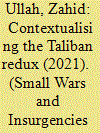

|
|
|
|
|
| Summary/Abstract |
After the Taliban takeover of Afghanistan, a Pakistan spy chief told journalists in Kabul: ‘don’t worry, everything will be okay’ in Afghanistan. What is interesting to note in this assertion is that Pakistan had consistently been accused of playing a ‘double game’ in the war on terror since 2001. This paper examines the return of the Taliban and Pakistan’s role in their victory in August-2021. In particular, it addresses the following questions: Why are Pakistan-Afghanistan relations so fraught? What is the pattern of Pakistan’s influence over the Afghan Taliban? How different is the post- 2021 Taliban regime from its Taliban predecessors (1996–2001)? What might the long-term implications of the Taliban victory be for Pakistan? This paper employs the security-cum-rentier state framework to explain Pakistan’s double game in the war on terror. Moreover, this paper aims to situate and contextualize the situation in Afghanistan (2001–2021) in the ongoing geopolitical rivalry, i.e. Quad/ Indo-Pacific Strategy (West) versus the Belt and Road Initiative (China). Methodologically, this study is based on secondary sources and some primary sources (official documents).
|
|
|
|
|
|
|
|
|
|
|
|
|
|
|
|
| 3 |
ID:
188334
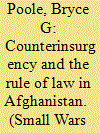

|
|
|
|
|
| Summary/Abstract |
A major aspect of the United States’ war efforts in Afghanistan over the past two decades has been the waging of a counterinsurgency campaign. This article analyzes the extent to which the United States and other Western intervening nations developed and implemented rule of law support missions as a component of the overarching counterinsurgency mission. This article evaluates the successes and failures of the rule of law missions, analyzing the lessons learned from two decades of conflict to provide a foundation for the policymakers and strategic planners who will be tasked with executing counterinsurgency campaigns in the future. The article focuses in particular on the social, political, and cultural factors of the Afghan people that impacted the viability of the Western counterinsurgency and rule of law missions.
|
|
|
|
|
|
|
|
|
|
|
|
|
|
|
|
| 4 |
ID:
188338


|
|
|
|
|
| Summary/Abstract |
At the end of 2021, the US Army published Modern War in an Ancient Land: The United States Army in Afghanistan, 2001–2014. It is a major two-volume history of the US Army in the war in Afghanistan. The primary authors are E.J. Degen, Director of the Army's Operation Enduring Freedom (OEF) Study Group, and Mark Reardon, a senior civilian historian at US Army Center of Military History. The work has 836 total pages of text and covers most intense period of US combat operations of the war. It is the closest thing that we have yet to an official history of the war and is likely to remain the closest thing for some time. The work contains valuable insights into counterinsurgency in Afghanistan. The authors see the concept as an effective tactical approach if properly aligned with strategy.
|
|
|
|
|
|
|
|
|
|
|
|
|
|
|
|
| 5 |
ID:
188340
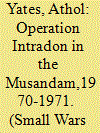

|
|
|
|
|
| Summary/Abstract |
This article examines Operation Intradon, a covert British counter-insurgency operation in the northern Omani enclave of Musandam. The operation, which ran from December 1970 to March 1971, was driven by the political aim of forcing the Sultan of Oman to take administrative control of this ungoverned enclave. This would then provide protection to the Strait of Hormuz oil route and remove a threat to the process of federating British protected states into what became the United Arab Emirates. We conclude by identifying what the operation says about how British military operations were crafted in Britain’s informal empire in the Gulf.
|
|
|
|
|
|
|
|
|
|
|
|
|
|
|
|
| 6 |
ID:
188339
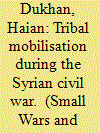

|
|
|
|
|
| Summary/Abstract |
As a result of the debilitating situation that the Syrian state reached during the Syrian Civil War, the government relies heavily on paramilitary groups to confront security challenges. Existing studies imply that all the paramilitary groups in Syria were formed in a largely top-down process. Focusing on the rise of al-Baqqer Brigade in Syria and relying on a series of in-depth interviews with members of the al-Baggara tribe who make up most of this militia, this paper challenges that assumption. The paper shows that the emergence of tribal militias is principally a grassroots phenomenon stemming from competition over local resources. It argues that the Syrian state has seized this opportunity and outsourced some of its security and counterinsurgency tasks to the group.
|
|
|
|
|
|
|
|
|
|
|
|
|
|
|
|
| 7 |
ID:
188336
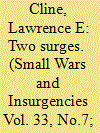

|
|
|
|
|
| Summary/Abstract |
As the strategic environments worsened both in Iraq and Afghanistan, the US tried to improve security by sharply increasing the number of troops. In the case of Iraq, the US achieved at least operational success, but the results were seemingly minimal in Afghanistan. Two factors were critical in Iraq: surge forces were focused on a relatively small center of gravity, and the operations were greatly assisted by the rise of the Awakening movement. The additional forces in Afghanistan had a much broader geographical area for their operations, and although efforts were made to mobilize local security forces, the results were at best mixed. The public time constraints on the additional forces in Afghanistan also were more prominent, leading to a ‘good enough’ approach by necessity. Although not strictly part of the surge, the US was able to turn over more security responsibilities to Iraqi forces as the ‘clear-hold-build-transfer’ process than they were to the Afghanistan forces. The results in Afghanistan in particular lead to questions as to how well expeditionary counterinsurgency forces can succeed in widespread insurgencies.
|
|
|
|
|
|
|
|
|
|
|
|
|
|
|
|
| 8 |
ID:
188335
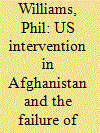

|
|
|
|
|
| Summary/Abstract |
Several factors militated against successful counterinsurgency in Afghanistan, but the real failure was a failure of governance. The US and its allies created a central government which proved extremely powerful at resource extraction while dismally weak at service provision, Development aid, the opium economy and the lack of political accountability created new forms of highly pernicious corruption, akin to those in many African states. The result was that legitimacy of the Afghan government was eroded, thereby setting the scene for a Taliban victory. The article concludes with three lessons from Afghanistan for the future.
|
|
|
|
|
|
|
|
|
|
|
|
|
|
|
|
|
|
|
|
|